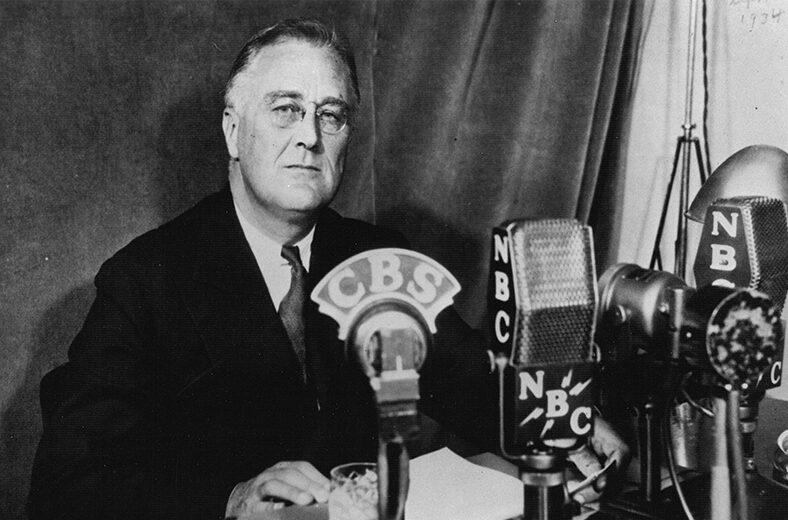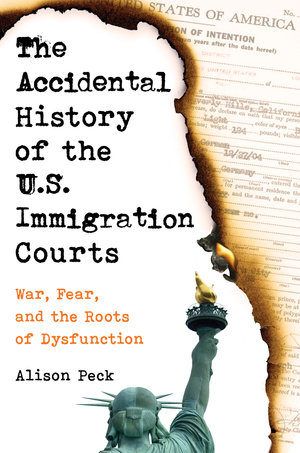By Alison Peck, author of The Accidental History of the U.S. Immigration Courts: War, Fear, and the Roots of Dysfunction
In 2018, as Attorney General Sessions handed down one decision after another that foreclosed avenues of immigration relief previously available to our clients, I began to search in earnest for an answer to a question that troubled me: Why did the attorney general – a Cabinet member and the top law enforcement officer of the government – have the power to act as a judge?
After years of teaching classes in administrative law, this didn’t fit with anything I knew about executive and judicial functions. No other executive branch official had such power to decide cases that could forcibly deprive people of their liberty – and effectively their lives, in many cases. Who decided to put a court system, with the power to decide such life-or-death questions in individual human lives, in the Department of Justice? Something didn’t make sense. This inquiry was the genesis of my new book, The Accidental History of the U.S. Immigration Courts: War, Fear, and the Roots of Dysfunction.
My initial research revealed the simple answer: The immigration services, sources said, were moved from the Department of Labor to the Department of Justice by President Franklin D. Roosevelt in May 1940 to protect against a potential “fifth column” of Nazi spies who looked like locals but might sabotage the country from within. The primary legal source, in the form of Reorganization Act No. V of 1940 and its message from the president, confirmed this explanation.
But the simple answer was unsatisfying. While the threat faced by FDR and the country in May 1940 was undoubtedly extreme, so were the consequences of placing a court system in a law enforcement agency. Separation of powers dictates that the executive power to investigate and prosecute should be separate from the judicial power to decide. And due process requires an impartial adjudicator before a person may be deprived of liberty. There are limits to these principles – all judges are, for example, employed by the sovereign. But clearly the arrangement, even if not unconstitutional, raised serious questions of justice, fairness, and sound administration of the law. While FDR was known to have been willing to abridge civil liberties in the face of the exigencies of war, he was surrounded by advisors who might have cautioned him about doing so. And the Nazi threat was not a surprise in May 1940. So why did FDR decide to move immigration into DOJ at that time?
As I researched, I realized that the simple answer did not satisfy me because what I really wanted was a human answer to an ostensibly “legal” question. As I dug through archives, carefully holding the very papers once passed between FDR and his advisors, I understood better why. The law is a human institution – designed, debated, enacted, and implemented by human beings. As a human creation, it can be understood only by understanding the human forces behind it – the personalities and the pressures; the relationships and the rejections; the bad weather or the ill health or the sheer accident of circumstance that led certain people to make certain decisions on certain days. I knew that FDR had made that decision in May 1940, and I soon learned that he did so against the advice of his attorney general, Robert H. Jackson. I wanted to understand, on a human level, why he did so.
Slowly the story came together, piece by piece, as I walked through the papers of the president and his advisors from those years. What I came to value most were the documents that helped me understand how it felt to be in their place. One story that spoke powerfully to me was a conversation that had nothing to do with the immigration services. On May 16, 1940 – thirty years to the day before I was born, as it happens – Roosevelt ended a long and grueling day by calling Assistant Secretary of State Adolf A. Berle, Jr. Roosevelt had been thinking of how to evacuate Americans in England and suggested that Bantry Bay, on the southern Atlantic coast of Ireland, might be a suitable evacuation point.

During World War I, a young Roosevelt had visited Ireland as Assistant Secretary of the Navy, touring the area with British officers and reporting home on the state of the bases and flying stations there. Twenty-two years later, Berle recounted in his diary, Roosevelt had been lying awake at night “facing the crashing truth that the British Empire might be passing out of existence and that we would have nothing between us and some pretty hostile Germans except the deep Atlantic.” Roosevelt, in his anxious insomnia, remembered that trip in 1918, driving along Bantry Bay and seeing beautiful Irish girls walking along the road. When the girls had opened their mouths to curse the British officers in the vehicle, Roosevelt recalled, he saw that their teeth were black and decayed. “Wouldn’t you think,” Roosevelt told Berle in 1940, “that one’s mind would make different kinds of pictures when things are going fast?”
As I sat upstairs in Roosevelt’s home – now the FDR Library – reading Berle’s account of that conversation, I felt the president alongside me. Instead of characters etched in black and white photographs, he and Berle became human beings, their lives as real and immediate and tenuous as mine, or yours. I could not relate to the pressure they must have felt at that time, but I could understand deeply how human and courageous and fallible they, and their decisions, ultimately were. I found a photograph of Roosevelt in the collection, looking intently at the camera from behind a radio station microphone. The look on the face of my new companion said, “I know. I did what I could. Now do better.”
This post is part of our #LSA2021 conference series. Visit our virtual exhibit page to get 40% off the book.

